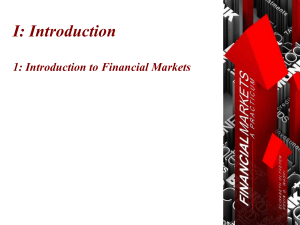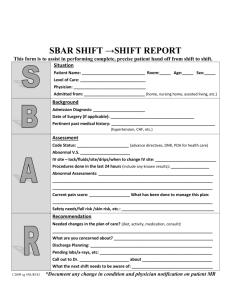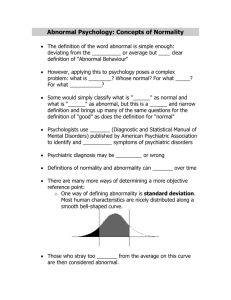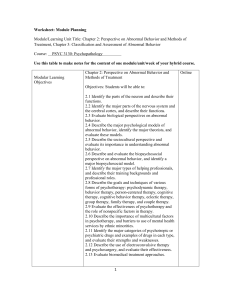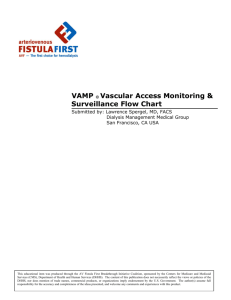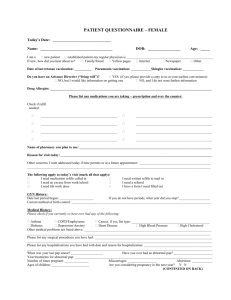Introduction to Financial Markets
advertisement
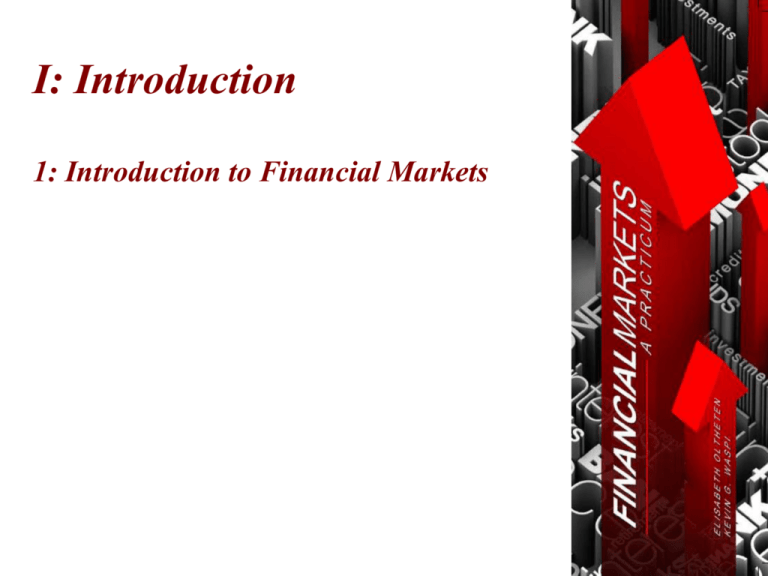
I: Introduction 1: Introduction to Financial Markets Dow Jones Industrial Average Chapter 1: Introduction to Financial Markets © Oltheten & Waspi 2012 Circular Flow CAPITAL LABOR HOUSEHOLDS FINANCIAL MARKETS FACTORS OF PRODUCTION LABOR MARKETS GOVERNMENT CONSUMPTION FIRMS PRODUCTION GOODS MARKETS Chapter 1: Introduction to Financial Markets © Oltheten & Waspi 2012 Markets Exist to bring buyers and sellers together Chapter 1: Introduction to Financial Markets © Oltheten & Waspi 2012 Markets Labor markets .February 3 & 4 2pm – 6pm ARC Chapter 1: Introduction to Financial Markets © Oltheten & Waspi 2012 Markets Primary market FINANCIAL MARKETS Secondary market FINANCIAL MARKETS Chapter 1: Introduction to Financial Markets © Oltheten & Waspi 2012 Circular Flow Chapter 1: Introduction to Financial Markets © Oltheten & Waspi 2012 Financial Markets Facilitate optimal allocation of . . through . Chapter 1: Introduction to Financial Markets © Oltheten & Waspi 2012 Returns Mechanism Normal Return . Abnormal Return . . Chapter 1: Introduction to Financial Markets © Oltheten & Waspi 2012 The beginning of a bubble Returns Mechanism Normal Return Chapter 1: Introduction to Financial Markets Abnormal Return © Oltheten & Waspi 2012 Efficient Markets Hypothesis Weak Form . Semistrong Form . Strong Form . Chapter 1: Introduction to Financial Markets © Oltheten & Waspi 2012 Technical Analysis Double Bottom (shaped like a W) [A] Breakout #1 [B] Breakout #2 [C] New Trend http://business.illinois.edu/finance_dev/Lesson21.asp Chapter 1: Introduction to Financial Markets © Oltheten & Waspi 2012 Fundamental Analysis Earnings Per Share (EPS) Net Income EPS Shares Outstanding Price/Earnings Ratio (P/E) Stock Price P/E EPS Chapter 1: Introduction to Financial Markets © Oltheten & Waspi 2012 Fundamental Analysis Current Ratio availability of working capital Total Current Assets CR Total Current Liabilities Quick Ratio liquidity Cash & Marketable Securities Accounts Receivable QR Total Current Liabilities Chapter 1: Introduction to Financial Markets © Oltheten & Waspi 2012 Fundamental Analysis Return on Assets (RoA) Net Income RoA Total Assets efficient use of assets Return on Equity (RoE) Net Income RoE Shareholders Equity profitability Gross Profit Margin on Sales MarginGross efficient use of factors of production Sales - Cost of Goods Sold Sales Chapter 1: Introduction to Financial Markets © Oltheten & Waspi 2012 Practice Questions Chapter 1: Introduction to Financial Markets © Oltheten & Waspi 2012 Q&P 1-1: I use my computer and Internet link to chart the movement of all 30 Dow Jones Industrial stocks. I buy and sell according to my analysis of these price movements. If I can generate consistent abnormal returns in this manner then this is a failure of Charles is a member of the Board of Directors of the Royal Bank. If he can generate consistent abnormal returns in trading Royal Bank shares then this is a failure of Varya checks out all the Value Line publications and buys everything that Value Line recommends. If she can generate consistent abnormal returns then this is a failure of I watch Wall Street Week every week. Then when it's over I throw a dart at the Wall Street Journal. I buy whatever the dart hits. If I can generate consistent abnormal returns in this manner then this is a failure of John Q. Investor analyses the quarterly earnings statements of some fifty obscure small-cap stocks. He then buys according to the earnings pattern disclosed. If he can generate consistent abnormal returns in this manner then this is a failure of Chapter 1: Introduction to Financial Markets © Oltheten & Waspi 2012 1: Financial Markets in the Economy
